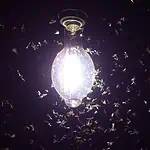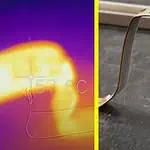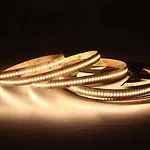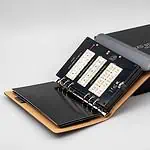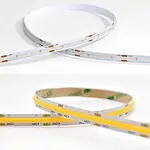Messed up with old or damaged LED strips light? Don’t know what to do with them? Well, you need to dispose of them in the proper way without affecting the environment.
Proper disposal of LED lights is really essential; otherwise, they can damage rivers or landfills. For starters, you can search for a waste recycling place where you can drop off or dispose of any electronic devices, including LEDs. Also, some manufacturing companies take back old or outdated LEDs; you can check and contact them. Besides, donating is good; if you find anyone who wants to use lights, you can give them. So, search for the perfect place or event where you can dispose of LED lights.
Therefore, I have mentioned here some fascinating facts you can follow for disposing of LEDs correctly. So, let’s dive into the beneath section without wasting more time–
What Is LED Strip Light & How Does It Work?
LED strip lights are also identified as LED tape lights. These are light-emitting diodes (LED) attached to a flexible printed circuit board. These diodes are made of semiconductor materials that produce light when electricity passes through them. The color of the light varies depending on the type of semiconductor materials. These fixtures are super flexible to use for a wide range of applications; you can easily cut and rejoin them to fit your location. Here are the primary parts of LED strip lights-
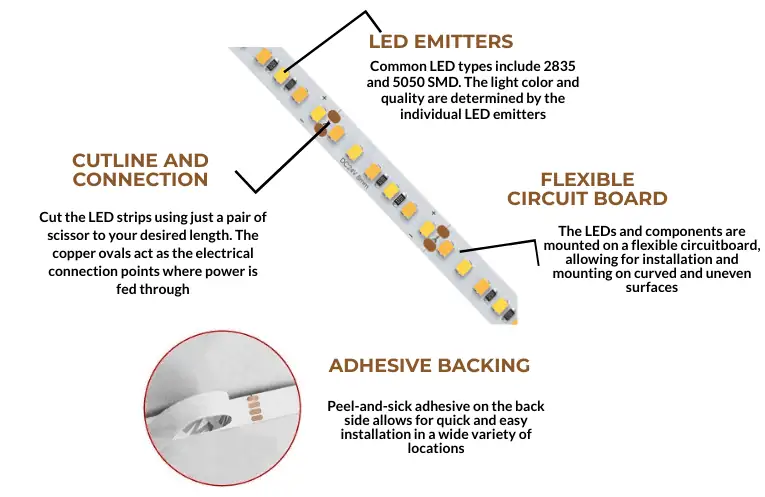
- LED Chip: LED chips are the key element of an LED strip that produces light. These chips are arranged throughout the body of the PCB. Depending on the size and density of LED chips, the lighting output of the fixture is greatly affected. To learn about the most common LED chip sizes, check this- Numbers and LEDs: What Does 2835, 3528, and 5050 Mean?
- Circuit Board: The LED chips of the strip lights are arranged within the circuit board, functioning as its structural unit. These printed circuit boards or PCBs are made of polyamide and are super flexible to fold or bend. You will find small cut marks within the circuit board to size the strips to your required length. And the best part is that two circuit boards can also be rejoined using an LED strip connector. For more information, you can check Everything You Should Know About FPCB.
- Resistor: The resistor of the LED strip controls the electricity passing through the lights. When the LEDs run by excessive current, they can get damaged. Thus, the resistor can prevent this situation and maintain prover voltage and current flow.
- Driver: LED strips, especially the low voltage ones, come with a driver to regulate the power source of the lights. They rectify higher voltage, alternating current to low-voltage, direct current. For more information, you can check A Complete Guide to LED Drivers.
- Capacitor: The capacitors in the LED strip balance the power supply and minimize flickering or any unwanted incident. However, not all LEDs contain capacitors. Usually, you will find this feature in advance strips. To learn more about the internal parts of LED strips, check this- LED Strip Light Internal Schematic and Voltage Information.
Advantages Of LED Strips
LED strip lights have several benefits. Let’s see here some of the most common advantages you will get while using LEDs–
- Energy efficiency: LED strip lights are more energy efficient than conventional lights, such as fluorescent tubes or incandescent bulbs. Instead of wasting energy on heat, they convert it into light. This way, these lights reduce the consumption of electricity. And it leads to lower bills so you can save money simultaneously.
- Environmentally friendly: Unlike some other types of light, the LEDs do not have any mercury. Also, they minimize carbon footprint as they are energy efficient, which affects environmental conservation.
- Adjustable: You can cut LEDs at any length you want. They are super flexible; you can customize the length according to your needs and install them easily for any project.
- Compact and flexible: These lights are slim, compact, and easy to set in several areas and environments. You can install them on irregular or curved surfaces as they bend vertically over 90 degrees. To know more, check this: How To Install LED Strip Lights Around Corners?
- Wide range of applications: The slim fit design and the robust structure of these fixtures are suitable for a wide range of applications. You can purchase these lights for decorative purposes, along with tasks, accents, under-cabinet lighting, and many more.
- Low heat emission: LED strip lights produce lower heat, which makes them safe to apply and minimizes the danger of overheating. Also, some LEDs are waterproof and dustproof.
- Color options: Besides monochromatic colors, LED strip lights are available in a wide range of color variants. You can choose tunable or dim-to-white LED strip lights for CCT customization. Again, the RGB LED strips allow you to create about 16 million hues, mixing the major three colors- red, green, and blue. And if you want to take the light color game to the next level, go for an addressable LED strip. They allow you to control each strip segment, creating a rainbow-like effect.
- Longevity: Where traditional incandescent lights last only 1000 hours, LED strips can run for 50,000 hours on average! This makes them ideal for residential, commercial, and industrial lighting. You no longer need to worry about frequent light replacement. However, our LEDYi LED strips come with a 3-5-year warranty, ensuring premium quality and longevity. For more information, you can check How Long Do LED Strip Lights Last?
Can You Dispose of LED Strip Lights?
You can dispose of LED strip lights; however, you must do that carefully without damaging the environment. Like other electronic gadgets, LEDs contain several materials, such as electronic and metal parts. These materials can harm the environment if they are not disposed of properly. However, disposing of LED strips can be easy and quick if you know and take the essential precautions. So, when you notice your LEDs are damaged or outdated, prepare to dispose of them. First, you have to switch off and unplug the strips from the power supply. Then, detach them from the adapters. If the lights are tangled, use a wire cutter to split them. So, by following these processes, you can dispose of the strip, avoiding the effect on the environment.
6 Ways To Dispose Of LED Light Strips
In this section, I have mentioned seven ways to dispose of LEDs. Following these, you can dispose of them properly when they get damaged or outdated. Take a look at them–
1. Regional Electronic Waste Recycling
Verify if your regional community or municipality offers programs or designated drop-off centers for electronic waste recycling. Many areas provide specific locations where you can responsibly discard LEDs and electronic devices. Contact those communities and give the fixture for recycling.
2. Authorized Recycling Centers
You can search for legitimate electronic waste recycling places in your region. These centers have the facility and expertise to handle LEDs and recycle their parts safely. Besides, the authorized recycling centers ensure the bulb you dispose of is in safe hands and will be properly taken care of.
3. Retailer Or Manufacturer Recycling Programs
Many LED strip light retailers or manufacturers provide recycling resources. So visit their website or search customer support to see if they have such services for the products. Being a cautious citizen, you should purchase fixtures from suppliers that run recycling programs. However, it is not so practical to look after these facts while purchasing a light, yet when disposing, check if the brand offers a recycling facility.
4. Household Hazardous Waste Collection Events
Some regions organize periodic collection events for household hazardous waste. LED strips can be permissible at these gatherings. For confirmation, you need to verify the schedules and locations by contacting your local waste management agency.
5. Donate
You may want to replace the aged/old fixtures when they are still in good condition and functional. In this case, the best option is to donate these lights to a regional charity or give them to somebody who wants to use them. This way, you can contribute to the rural community and be stress-free about disposing of LEDs.
6. Special Collection Days
Many areas contain special collection days for eclectic waste, where people can drop off LEDs for recycling. Search for these kinds of events in your community. Then, leave your damaged LEDs there. When discarding LED strip lights, ensure to eliminate batteries or power sources before recycling. Moreover, adhere to local regulations or guidelines governing electronic waste disposal.
Why Proper LED Strip Disposal Is Important?
- Waste reduction: By disposing of it properly, you can recycle and recover the valuable parts of the LEDs. This way, you can reduce the electricity waste that usually ends up in rivers or landfills.
- Environmental impact: Strip lights have electronic and metal parts. When they are not disposed of correctly, the material can free destructive stuff into nature. As a result, they will pollute water and soil sources.
- Resource conservation: Reusing LED strip lights aids in preserving essential natural resources utilized during manufacturing, including rare earth metals and various raw materials.
- Legal compliance: Many areas have specific regulations and laws about electronic garbage disposal. So, you need to follow these regulations’ fulfillment to improve a secure nature while dumping strip lights.
- Preventing health hazards: If you don’t handle and properly throw the LEDs, the lead or other parts of the strip lights can cause health risks. So, to prevent health problems for the public and waste workers, you need to dispose of them correctly.
- Supporting the recycling industry: By disposing of strips, you can support the recycling companies and inspire them to invest in environmentally friendly businesses.
- Sustainable practices: Proper disposal practices adhere to sustainability principles and promote a circular economy. This way, you can prioritize the reuse and recycling of materials to reduce waste and conserve resources.
- Minimizing energy consumption: When you recycle and resume valuable parts of strip lights, it requires less electricity than the production of new ones. Hence, adequate disposal can reduce energy consumption.
- Setting an example: Last but not least, when any individual or company takes responsibility for disposing of LEDs, they actually set an example for others to follow. Also, this promotes natural consciousness and liable waste control practices for everyone. So, you can do this and set an example for doing good and inspiring others.
FAQs
Yes, LED strips are recyclable. But you need to follow proper recycling procedures. For example, remove the batteries before recycling and go with the local regulations to dispose of the fixture. However, the best recycling solution is to contact a program or supplier that takes back old or damaged fixtures.
No, LEDs consume significantly less energy than traditional bulbs. More specifically, LED lights use over 75% less energy than their incandescent bulbs. And 80% of the energy is converted to light and the rest 20% to heat. Thus, minimal energy is wasted, which makes it highly efficient. LEDs do not waste electricity; rather, they consume less electricity.
LED strips are safe to use as they usually run under low voltage. These lights are designed to produce less heat and reduce the danger of overheating. So you can turn them on all night without worrying about accidents. But, it’s best to purchase LED lights from manufacturers with justified safety certifications.
No, LED strip lights do not increase electricity bills instead, they can reduce bills in the long run. Also, strip lights are more energy efficient compared to conventional bulbs and use less energy. So you can save energy and decrease electricity bills by using LEDs.
Yes, you can use LED strip lights for outdoor purposes. But for this, you must purchase a strip fixture with a higher IP rating. For instance, an IP66 LED strip is completely dustproof and can withstand heavy rain to survive in outdoor decoration.
Usually, LED lights last over 50,000 hours. But it depends on the light’s quality and how you use them. Therefore, to make the LED strips last longer, you must follow proper maintenance. For instance, correct voltage and electricity supply, installation, ventilation, and more.
An alternative to LED lights is compact fluorescent lamps (CFLs). Because they are energy-efficient and longer-lasting. However, the drawback is that CFL bulbs contain mercury. If CFL bulbs break at your home, they release mercury, which harms the environment.
Final Thoughts
For an eco-friendly future, it is essential to emphasize the correct disposal of LED lights. There are many ways to do so. For instance, you can contact electronic waste recycling programs, authorized centers, or retailer initiatives. But as LED strips don’t contain any harmful elements like mercury, you can also dispose of them in your house’s regular dustbins. In this case, it is better to wrap the damaged LED strips in a fabric/paper or something soft. Thus, if the bulb breaks off, it will not harm animals searching for food in the garbage.
However, choose a fixture that lasts longer if you don’t want to take the hassle of frequent LED strip light disposal. Here, the best option for you is LEDYi LED strips. All our fixtures are of high quality and have a 3-5 year warranty. So, in this period, if your fixture faces any sort of issue, feel free to contact us; we are here to solve the issue. Therefore, place your order ASAP!



